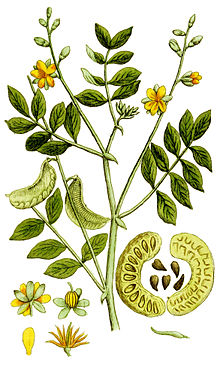Senna (genus)
| Senna | |
|---|---|
 |
|
| Senna alexandrina | |
| Scientific classification | |
| Kingdom: | Plantae |
| (unranked): | Angiosperms |
| (unranked): | Eudicots |
| (unranked): | Rosids |
| Order: | Fabales |
| Family: | Fabaceae |
| Subfamily: | Caesalpinioideae |
| Tribe: | Cassieae |
| Subtribe: | Cassiinae |
| Genus: |
Senna Mill. |
| Type species | |
|
Senna alexandrina Mill. |
|
| Species | |
|
Over 300; see text |
|
| Synonyms | |
|
|
Over 300; see text
Senna (from Arabic sanā), the sennas, is a large genus of flowering plants in the legume family Fabaceae, and the subfamily Caesalpinioideae. This diverse genus is native throughout the tropics, with a small number of species in temperate regions. The number of species is estimated to be from about 260 to 350. The type species for the genus is Senna alexandrina. About 50 species of Senna are known in cultivation.
Senna includes herbs, shrubs, and trees. The leaves are pinnate with opposite paired leaflets. The inflorescences are racemes at the ends of branches or emerging from the leaf axils. The flower has five sepals and five usually yellow petals. There are ten straight stamens. The stamens may be different sizes, and some are staminodes. The fruit is a legume pod containing several seeds.
Chamaecrista, Cassia, and Senna form a monophyletic group which some authors have called Cassia sensu lato. In 1982, the group was named Cassiinae and classified as a subtribe of the tribe Cassieae. The tribe Cassieae contains 21 genera and is now known to be polyphyletic, but the classification is still accepted because a revision of Fabaceae has yet to be published.
...
Wikipedia
